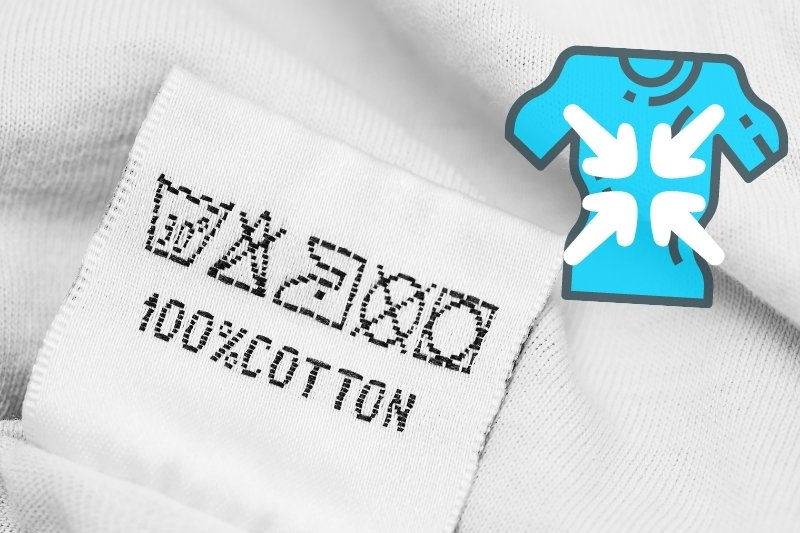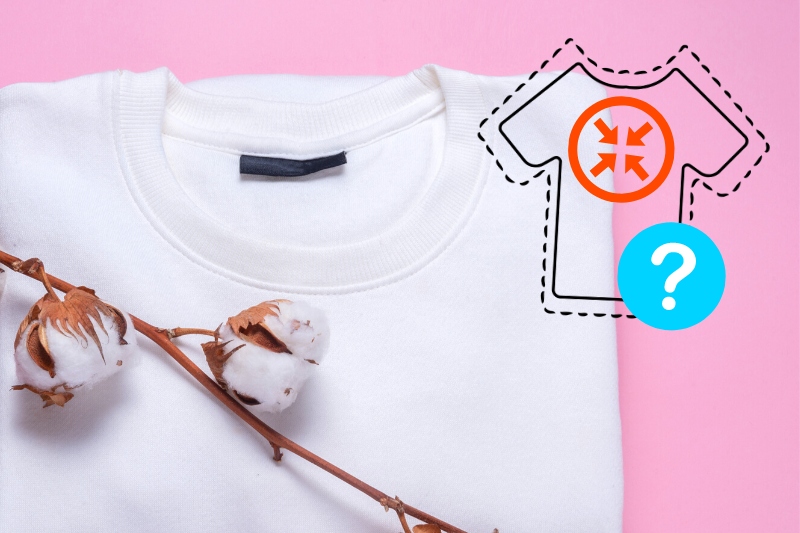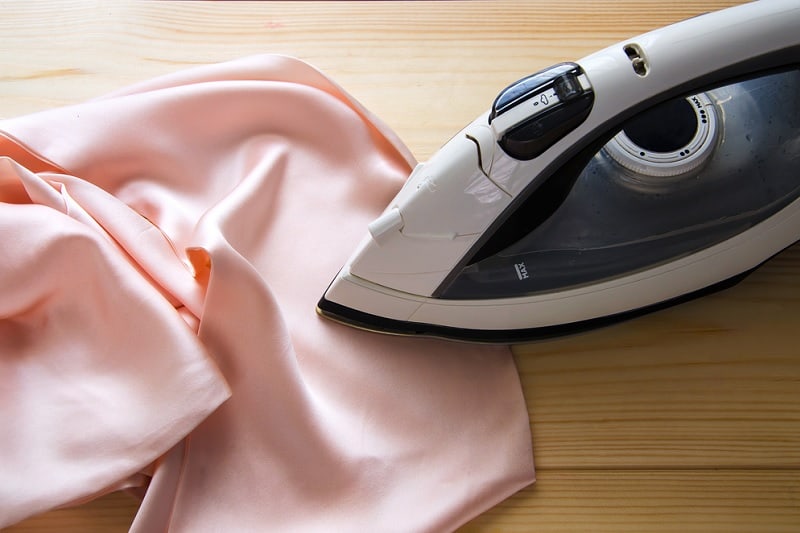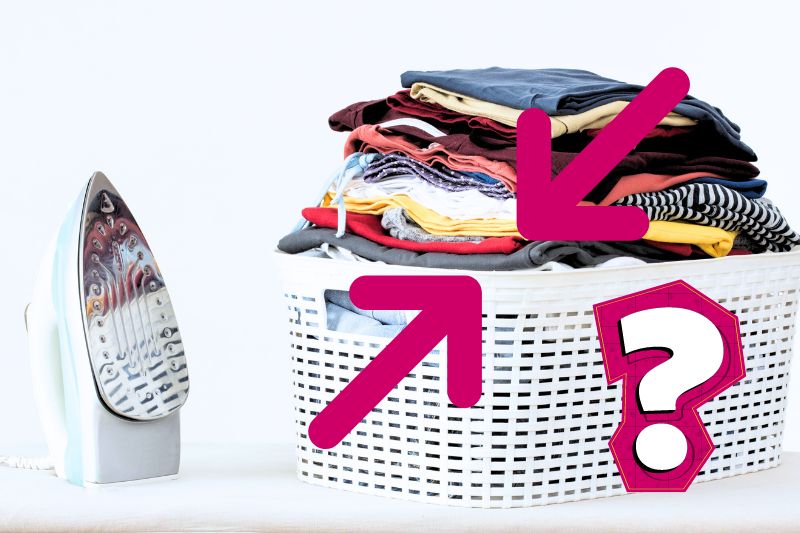Several factors impact whether or not your items will shrink when being ironed. These include:
- The material
- The iron’s temperature
- The moisture level of the material
- If the garment has been pre-shrunk
In short, ironing damp fabric with too much heat can lead to shrinkage. This happens because the high heat and moisture mixture causes the material’s fibres to contract more than they would if they were dry-ironed or ironed on a lower, more appropriate heat setting.
Different materials react differently to moisture and heat, with natural fibres like cotton and wool being more susceptible to shrinkage under these conditions than synthetic fibres.
To prevent shrinkage, it’s essential to use the correct temperature setting on the iron and to avoid excessive heat, especially when ironing damp items of clothing.
Remember that while ironing can cause some shrinkage, the iron isn’t the only appliance that can affect your clothes. Your outfits can shrink when washed and dried because they’re subjected to the wrong washing or drying cycle (too much heat, an overly long cycle and excessive agitation). Put all these factors together, and you have a recipe for shrinking your laundry.
Let’s look at this in more detail.
Factors That Make Clothes More Prone to Shrinkage
Material

Natural fibres, like cotton, silk and wool, are more prone to shrinkage. Why? These fibres absorb water quickly, making them swell and change shape.
When you apply heat to these fibres, in this case through ironing, it accelerates the evaporation of the water, which causes the fibres to contract quicker than they would normally. This is caused by:
- Moisture absorption, expansion of microscopic fibre pores, and contraction of the pores.
- Molecular motion in the fibres increases under heat.
- For wool, scales on the fibre’s surface can interlock tightly after rapid heating and evaporation, making the fibres shorter.
The overall result is a shrunken outfit.
Manmade fibres like polyester, acrylic and nylon, on the other hand, are less likely to shrink when ironed.
Why? The fibres in these materials react differently to heat and moisture. They can sometimes warp when exposed to high heat but don’t usually absorb as much water. This, in turn, minimises the risk of shrinkage.
When ironing, you must check the tag on your outfit, find out what material you’re dealing with and change the setting on your iron to match the fabric. Not doing so may result in you using the wrong temperature to iron your outfit. This, in turn, will lead to shrinkage.
Heat settings
As mentioned above, applying heat to a damp fabric speeds up the evaporation of the water in the material. This leads to the fibres contracting faster than they really should, and you end up with smaller garments. Naturally, the hotter the heat, the faster this effect will be.
How much shrinkage you can expect depends on how sensitive your fabric is to heat and how wet it is. Damp, natural fibres are more likely to shrink quickly, for example.
It’s imperative that you choose the correct heat setting on your iron for the material you’re ironing. You can manually select a temperature or some irons list materials’ names, like ‘cotton’ or ‘linen’, which you can pick. The iron will then adjust the heat based on what you’ve picked.
Moisture
Heat can do a lot of damage on its own, but when paired with water, it can do even more harm.
When items are filled with moisture, particularly garments made from natural fibres, the fibres relax and swell, but the size of the outfit decreases. (This is most commonly known as ‘relaxation shrinkage’).
If you don’t want your clothes to shrink too much, ensure they’re relatively dry before you iron them. And only mist them with a bit of liquid as and when needed.
In addition, if an item is damp, cover it with an ironing cloth to limit the transfer of heat from the iron to the outfit.
Pre-shrunk?

Many garments will have gone through a pre-shrinking process before they get to you. This means the items are less likely to or won’t shrink as much when you wash them at home. It essentially keeps the item intact and in better condition for longer.
If you’re ironing an item that hasn’t been pre-shrunk during the manufacturing process, you could shrink it when you’re ironing it. This is especially true if your garment is damp, ironed on the wrong heat setting, and falls under the ‘heat sensitive’ category.
On the flip side, pre-shrunk items are less likely to shrink because they’ve already been shrunk. Stick to buying these clothes if you’re worried about shrinking your clothes as you iron them.
How to Stop Clothes Shrinking When Being Ironed
Take note of the tips below to prevent your outfits from shrinking when being ironed.
- Read the care labels on your clothes to find out if and how they should be ironed. For example, some clothes, like stretchy ones, shouldn’t be ironed because you could permanently damage the material. Similarly, you’ve got to be careful with delicate fabrics like satin, silk and lace because they can’t withstand high heat.
- Use the right temperature for the material you’re ironing. For example, cotton and linen can withstand higher temperatures, whereas wool must be ironed on a low heat and alongside an ironing cloth (stops shininess and burning). Synthetics, on the other hand, must be ironed with very little heat so that they don’t melt or warp.
- Ensure that the iron is constantly moved around the garment and not left on one patch of material for too long. Leaving the iron in one place can scorch the fabric or make it shiny.
- Make sure you’ve laundered your clothes properly beforehand. For example, select cooler water temperatures, minimal spin speeds, and shorter washing cycles.
- Always do a patch test if you’re concerned. Iron a little patch of material and watch what happens. If nothing terrible happens, continue to iron your item.
- Buy pre-shrunk clothes to limit the effects.
- Protect your clothes from potential damage by covering them up with a pressing cloth. This cloth will stop excessive heat from getting to and damaging your items.
Tip: If your item doesn’t have a care label, iron the piece with the lowest amount of heat. You can then increase the temperature slowly until the crinkles start to disappear. In addition, use an ironing cloth (pressing cloth). Doing this will ensure you don’t scorch the material.
How to Intentionally Shrink Clothes Using an Iron

If you’ve got a garment that’s too big, you can intentionally shrink it using an iron.
Follow the steps below:
- Fill a spray bottle with hot water. Skip this step if your item is already damp.
- Lay the item flat on an ironing board.
- Squirt the warm water over it – the item should end up damp.
- Select an appropriate heat setting on the iron.
- Rub the iron back and forth over the fabric until it is dry.
- If you’ve not shrunk the item enough, repeat the steps above.

Bethan has a passion for exploring, reading, cooking and gardening! When she’s not creating culinary delights for her family, she’s concocting potions to keep her house clean!






